Stonegrave and Caulkleys Bank from Nunnington
7 miles Fine but cool wind
This was a new walk to us and the most southerly in Tom Scott Burns' book The Walker's Guide to the Hambleton Hills, being four miles south of Helmsley. We drove to Nunnington via the B1257 Malton road and parked at the roadside, across the river from Nunnington Hall.
 |
| Today's walk from The Walker's Guide to the Hambleton Hills |
 |
| The River Rye from our car park |
 |
| Nunnington Hall |
Tom Scott Burns explains that the name Nunnington is derived from the Old English personal name Nunna and not from the Saxon nunnery that was originally on the site of Nunnington Hall. We walked through the village and our route left the road at a sign and followed the winding path of the River Rye.
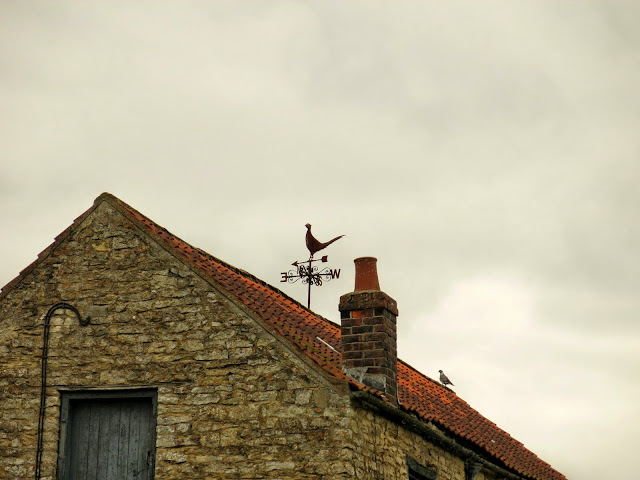 |
| Pheasant weathervane in Nunnington |
 |
| The Old School House, Nunnington |
 |
| Nunnington |
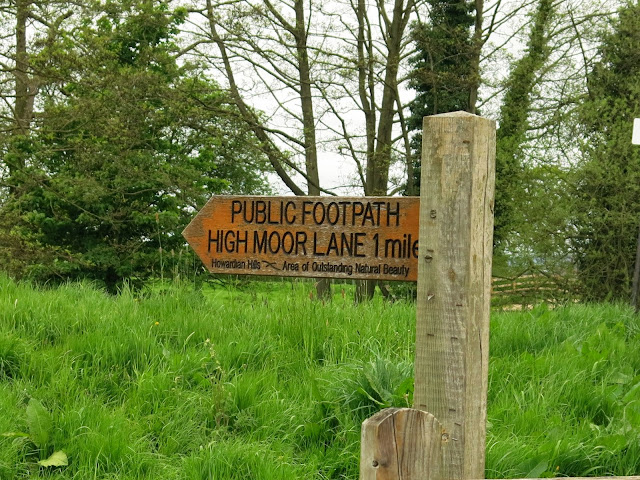 |
| We leave the road.... |
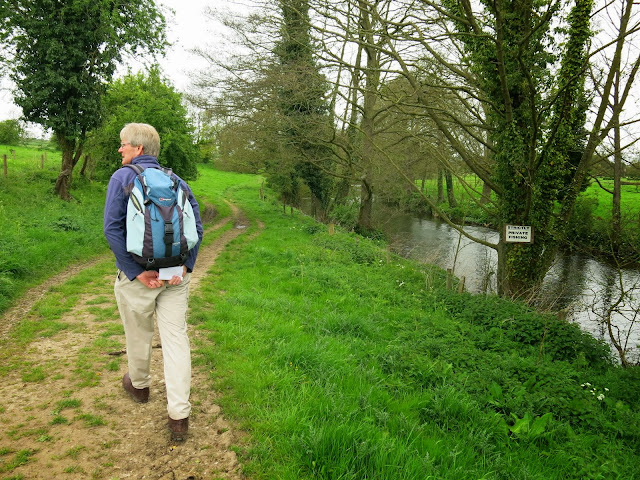 |
| ... and follow the river |
Our path followed the river bank for about 1.5 miles until we veered left, crossed a small beck and turned left again, into High Moor Lane. We soon reached a tarmac road and turned left onto it, then after a hundred yards, right into fields. The field path took us straight across three or four meadows until we could see the roof-tops of Stonegrave below us.
 |
| Cross it if you dare, we didn't! |
 |
| Field paths after High Moor Lane |
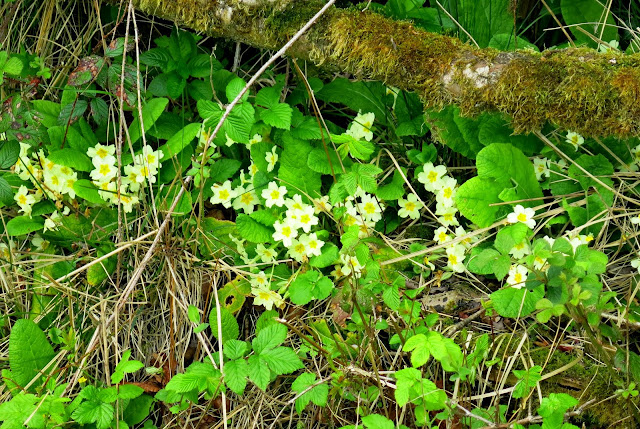 |
| Lots of primrose at the field edge |
 |
| We turn left to ... ? Sign should say STONEGRAVE |
We were amazed at the amount of stone in the fields which showed particularly in the furrows of the potato fields. We reached the busy B1257 at Stonegrave and walked through the village, passing by our path to Caulkleys Bank on the left as we wanted to see the church, actually a Minster and the smallest in the country, which has been on this site since the 8th century.
 |
| Field path to Stonegrave |
 |
| Potato fields full of limestone chips |
 |
| We reach the B1257 and see the Minster ahead |
 |
| Stonegrave Manor House, some windows bricked to avoid the Window Tax of 1696 |
 |
| First view of the Minster |
TSB explains that the name Stonegrave is from Old Norse 'steinn-gryfja' meaning stone cleft, as there was extensive stone quarrying here in the middle ages. The Minster is mentioned in an 8th century letter from Pope Paul I to King Eadbert of Northumbria. As we approached it we passed by a lovely Elizabethan manor house whose honey coloured stones made it look as if it had been built only yesterday. The Minster was unlocked and just inside its door we saw a Celtic Circle Cross which is almost complete. An adjacent notice pointed out that such crosses are only found in the North East. It was an attractive building and after exploring we decided to make use of the bench outside to enjoy our coffee and scones, sheltered from the cool wind.
 |
| Clive wanders around the perimeter of Stonegrave Minster |
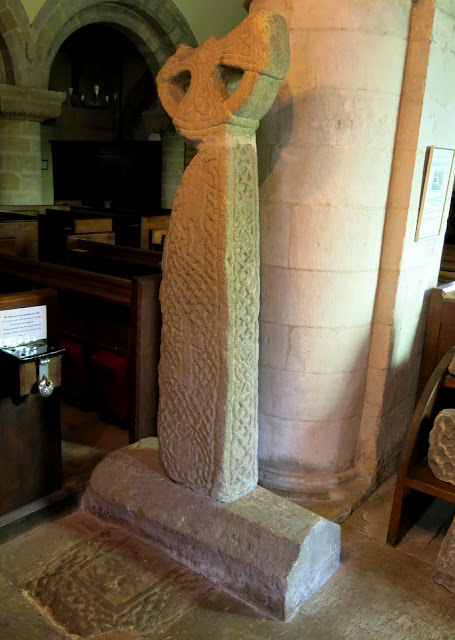 |
| 8th Century Celtic cross |
 |
| One of many Norman heads, this one next to the entrance of the Minster |
 |
| Stained glass windows at Stonegrave Minster |
 |
| From a sign in Stonegrave Minster |
We retraced our steps to reach the footpath to Caulkleys Bank. Caulkleys is a corruption of 'chalk lands'. The path runs off the B1257, sign-posted 'Caulkleys Bank' and we followed the wide grassy path uphill and to the left of a small wood. We now followed a fine broad path along a high ridge for the next 3.5 miles, and TSB claims that no less than 22 towns, villages and hamlets and sixteen churches may be seen from the ridge's highest point. We didn't check. Eventually we started to drop gently down to the houses of West Ness and back to the River Rye.
 |
| Leaving the B1257 |
 |
| Caulkleys Bank |
 |
| Looking down from the ridge walk |
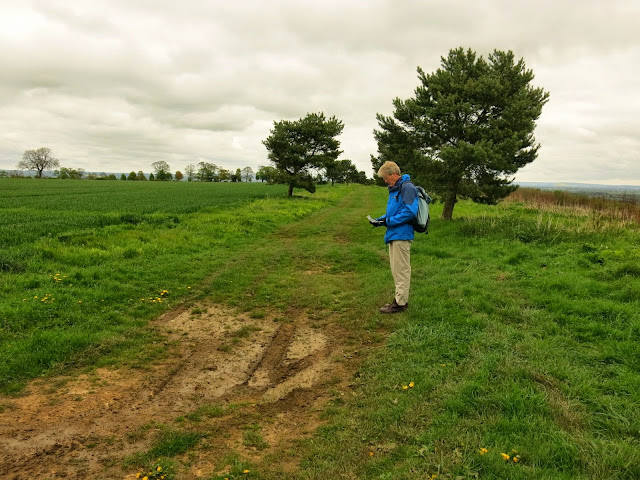 |
| Checking the route |
 |
| Starting the descent to Ness |
 |
| Entering West Ness |
As we entered the hamlet to West Ness we saw a stall at the side of the road offering fresh baked cakes. It was unmanned and a sign warned that we were being watched by CCTV. A list of vehicle registrations whose drivers had stolen goods from the stall was posted above the cakes. Literally a sign of the times!
 |
| £6 for a bag of sheep feed. A bargain if we had any sheep! |
 |
| Sadly there were no scones so no purchase made. |
|
|
We passed by an old Wesleyan Chapel, built in 1836 but now obviously disused, and joined a riverside track just left of the bridge. We followed the river back towards Nunnington and came to a large building that had once been a mill. In fact, TSB says there has been a mill on this site since the Domesday Book although the present one dates from 1875. As we entered the field next to the mill three geese ran towards us necks outstretched, but it turned out to be just a plea for food and not an attack party thank goodness.
 |
| Wesleyan Chapel |
 |
| Back to the river |
 |
| Approaching Mill Farm |
 |
| The old mill building |
 |
| Food! |
 |
| Mill Farm |
 |
| Nunnington Hall from The Avenue |
The river path took us back to Nunnington and Nunnington Hall, which was owned by Sir Thomas Parr in the 16th century, so it's quite possible that Catherine Parr, Henry VIII's last wife, could have played here as a child. We emerged on to The Avenue and went back through the village, this time to the Church of All Saints and St James, which we knew from last week's walk contains the remains of Peter Loschy, the dragon slayer. The church was open and we soon found the effigy of a knight with a dog at his feet.
 |
| The Church of All Saints and St James, Nunnington |
 |
| Peter Loschy and his dog? |
 |
| The dragon story from a church notice |
The church was very attractive with a fine Victorian organ. After a look around the interior we wandered the graveyard, as always fascinated by the bleak Victorian epitaphs.
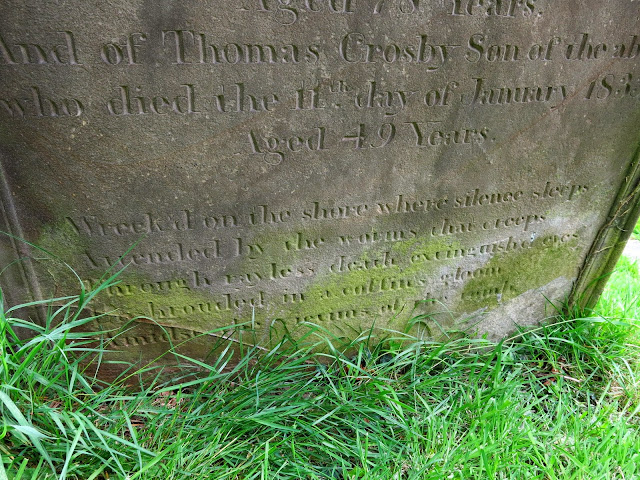 |
| 'Wrecked on the shore where silence sleeps/ Attended by the worm that creeps/ Through rayless death-extinguished eyes/Enshrouded in a coffin's gloom, Amidst the victims of the tomb' See note below | |
|
Leaving the church we noticed that the Royal Oak was just across the road and it seemed only fitting to reflect on our walk over a pint of York Brewery's Thumper Ale.
"To short walks and long drinks!"
NB With regard to the epitaph above, a google search showed that this is the first verse of a poem called 'Lorenzo', without the last line, from a book called The Remains of Joseph Blackett. The poem's title being: 'Lorenzo, Founded on the fact of persons having been buried alive.' The verse goes:
'Wrecked on the shore where silence sleeps, attended by the worm that creeps, through ray-less death extinguished eyes, enshrouded in a coffins gloom, amidst the victims of the tomb, the young Lorenzo prematurely lies'
Why anyone would want this as an epitaph is a mystery!
No comments:
Post a Comment